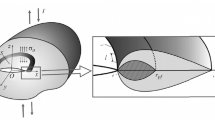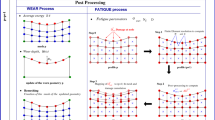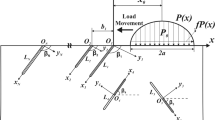Abstract
Within the framework of the concepts of fracture mechanics, we propose a numerical-analytic model for the investigation of fracture processes and evaluation of the durability of contacting bodies under the conditions of fretting fatigue. A key element of this model is the step-by-step construction of the paths of propagation of fatigue cracks by using the criteria of local fracture in a complex stressed state, the equations of propagation of a fatigue crack, and the characteristics of cyclic crack resistance of materials. We construct the paths of propagation of edge cracks in the contact zone of one of the bodies subjected to fretting. We assume that the crack growth is controlled by a stress intensity factor of the mixed type KIθ, which is determined by the criterial relations of the Oθ- criterion, and that the path of a crack is formed by the maximumIθ values in the contact cycle. The dependence of the path shape on the amplitude of the friction factor, the scheme of interaction between the bodies in the contact cycle, the initial lengths of cracks, and their orientation are studied. We show that the obtained theoretical results correlate with experimental data and give an example of calculation of the residual durability of the near-surface layer of VT3-1 titanium alloy in the contact zone.
Similar content being viewed by others
References
R. B. Waterhouse,Fretting Corrosion, Pergamon, Oxford (1972).
J. A. Collins,Failure of Materials in Mechanical Design: Analysis, Prediction, Prevention, Wiley, New York (1981).
L. T. Balatskii,Fatigue of Shafts in Joints [in Russian], Tekhnika, Kiev (1972).
S. V. Serensen,Resistance of Materials to Fatigue and Brittle Fracture [in Russian], Atomizdat, Moscow (1975).
N. L. Golego, A. Ya. Alyab’ev, and V. V. Shevelya,Fretting Corrosion of Metals [in Russian], Tekhnika, Kiev (1974).
K. L. Johnson,Contact Mechanics. Cambridge Univ. Press, Cambridge (1985).
Yu. V. Kolesnikov and E. M. Morozov,Mechanics of Contact Fracture [in Russian], Nauka, Moscow (1989).
L. A. Sosnovskii, N. A. Makhutov, and V. A. Shurinov, “Fretting fatigue: principal regularities,”Zavod. Lab., No. 8, 45–62 (1992).
Fretting Fatigue: Proc. Int. Conf. of Fretting Fatigue, The University of Sheffield, Sheffield, UK (1993).
D. A. Hills and D. Nowell,Mechanics of Fretting Fatigue. Kluwer, Dordrecht (1994).
D. P. Rooke and D. A. Jones, “Stress intensity factors in fretting fatigue,”J. Strain Anal.,14. No. 1, 1–6 (1979).
L. A. Dekhovich and N. A. Makhutov, “Application of fracture mechanics to the evaluation of fretting-fatigue strength,”Fiz.-Khim. Mekh. Mater.,17, No. 3, 86–90 (1981).
V. T. Troshchenko, G. V. Tsybanev, and A. O. Khotsyanovsky, “Two-parameter model of fretting fatigue crack growth,”Fatigue Fract. Eng. Mater. Struct.,17, No. 6, 15–23 (1994).
U. S. Fernando, M. W. Brown, and K. J. Miller, “Linear elastic fracture mechanics interpretation of crack growth behaviour in fretting fatigue,” in:Advances in Fracture Resistance in Materials (ICF-8 Proceeding), Vol. II, McGraw-Hill, New Delhi (1996). pp. 207–215.
V. Lamacq and M.-C. Dubourg, “Modelling of initial fatigue crack growth and crack branching under fretting conditions,”Fatigue Fract. Mater. Struct.,22, No. 6, 535–542 (1999).
V. V. Panasyuk(editor),Fracture Mechanics and Strength of Materials: Handbook [in Russian], in 4 Vol. Naukova Dumka, Kiev (1988-1990).
S. Faanes, “Inclined cracks in fretting fatigue,”Eng. Fract. Mech., No. 52 (1), 71–82 (1995).
O. P. Datsyshyn and R. B. Shchur, “Propagation of edge cracks under the conditions of fretting fatigue,”Probl. Tribol. No. 2, 7–16 (1998).
O. P. Datsyshyn and V. V. Panasyuk, “Durability and fracture calculational model of solids under their contact interaction,” in: J. Petit (editor).Mechanisms and Mechanics of Damage and Failure (ECF-11), Vol. II. EMAS, Warley, UK (1996), pp. 1381–1386.
O. P. Datsyshyn, “Fracture and wear processes simulating under cyclic contact of solid bodies,” in: J. Petit (editor),Mechanisms and Mechanics of Damage and Failure (ECF-11), Vol. II, EMAS, Warley, UK (1996), pp. 1411–1416.
O. P. Datsyshyn, “A computational model for the investigation of fracture and evaluation of the durability of structural materials under fretting fatigue,” in:Scientific Bull. “Forestry before the XXI Century: Education, Science, Production [in Ukrainian], No. 9.6, L’viv (1999). pp. 139–149.
O. P. Datsyshyn, R. E. Pryshlyak. S. V. Prykhods’ka, et al. “Effect of the form of model contact load on the stress intensity factors for an edge crack.”Probl. Trybologii, No. 3, 3–16 (1998).
M P. Savruk,Two-Dimensional Problems of Elasticity Theory for Cracked Bodies [in Russian], Naukova Dumka, Kiev (1981).
S. Ya. Yarema, “Propagation of curvilinear cracks in plates,”Izv. Akad. Nauk SSSR. Mekh. Tverd. Tela, No. 2, 156–163(1988).
O. P. Datsyshyn and R. B. Shchur.Analysis of the Parameters of Fracture Mechanics for an Elastic Half-Plane Weakened by an Edge Crack Under the Action of Constant Pressure at the Half-Plane Boundary [in Russian], Dep. in DNTB of Ukraine. 5.05.96, No. 1121-UK96. Kiev (1996).
K. J. Nix and T. C. Lindley, “The application of fracture mechanics to fretting fatigue,”Fatigue Fract. Eng. Mater. Struct.,8. No. 2, 143–160(1985).
P. R. Edwards, “Fracture mechanics application to fretting in joints.” in:Proc. 6th Int. Conf. Fract. (ICF-6) “Adv. Fract. Res. ” (New Delhi. 1984), Vol. 6, Oxford (1984), pp. 3813–3836.
L. R. Borvina, S. Ya. Yarema, V. V. Grechko, and L. V. Limar, “Kinetics of fatigue fracture of VT3-1 titanium alloy.”Fiz.-Khim. Mekh. Mater.,17, No. 6, 39–45 (1981).
Author information
Authors and Affiliations
Additional information
Translated from Fizyko-Khimichna Mekhanika Materialiv,Vol. 36, No. 2, pp. 5–19, March-April, 2000.
Rights and permissions
About this article
Cite this article
Panasyuk, V.V., Datsyshyn, O.P. & Shchur, R.B. Residual durability of solids contacting under conditions of fretting fatigue. Mater Sci 36, 153–169 (2000). https://doi.org/10.1007/BF02767536
Received:
Issue Date:
DOI: https://doi.org/10.1007/BF02767536




